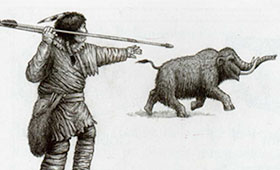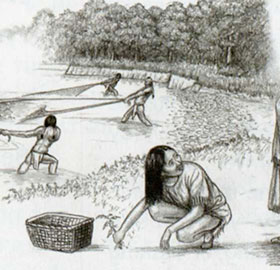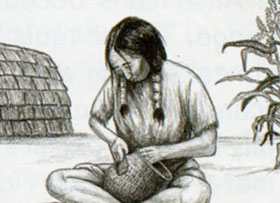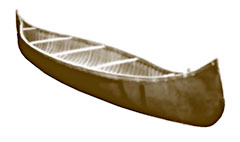South Burlington
Prehistory
PALEOINDIAN (11,500 - 9,000 years ago)
 Paleoindians hunted large mammals, such as elk, caribou, mammoths, and mastodons, many of which are now extinct
Paleoindians hunted large mammals, such as elk, caribou, mammoths, and mastodons, many of which are now extinct Click to view larger image.
South Burlington's landscape has changed dramatically since the glaciers started their retreat northward over 13,000 years ago. As the glaciers retreated, they left park-tundra conditions in their wake. These wide, expansive grasslands supported small populations of Paleoindians, who were itinerant hunters following herds of elk, mammoths, and caribou through the Champlain Valley and the Connecticut River Valley to the east. As rising temperatures continued to warm Vermont, the land continued to evolve and spruce and fir started reclaiming the landscape. At the same time, over a hundred large mammals, previously a staple in the Paleoindian diet, were going extinct, whether due to overhunting or climatic shifts and other environmental factors. With the glaciers melting, this left a channel from the Atlantic to the Champlain Sea. This filled the valley not just with salt water from the Atlantic, but also with an abundance of marine fauna (e.g. the Charlotte whale, a beluga whale).
ARCHAIC (9,000 - 3,000 years ago)
 Large game mostly extinct, Archaic Indians relied on fish, smaller game, and plants for much of their diet.
Large game mostly extinct, Archaic Indians relied on fish, smaller game, and plants for much of their diet.Click to view larger image.
Drastic changes in the landscape made the Paleoindian way of living obsolete and rewarded those that became more sedentary. With the closing of the Champlain Sea, absence of large game, and presence of thick forests (the forests were beginning to switch to maple, birch, and beech by about 7000 years ago), Paleoindians needed to adapt to a changing world. a new way of life, known as the Archaic culture, took root in Vermont. Freed of the heavy weight of 10-20,000 foot-thick glaciers, the North American plate began to rebound, which closed off the Champlain Sea, and therefore access to marine mammals and large fish. Foraging, fishing, and small game became increasingly important to the Indians. These alternatives provided a more diverse food source, but required new tools and skills to acquire them. These hardwood forests could not support large game such as before and hunting became less rewarding. Smaller game such as rabbit, deer, and squirrel could not alone sustain the human population. As a result, plants became increasingly import-ant in daily life, not just as medicine, but as a staple food source providing year-round nutrition. By about 4300 years ago, as the Archaic period neared its end, , the forests of Vermont were much as we would find them today.
WOODLAND (3,000 - 400 years ago)
 Agriculture provided much of the Woodland diet. Settlements were now more permanent.click to view larger image
Agriculture provided much of the Woodland diet. Settlements were now more permanent.click to view larger imageWoodland culture is the direct forebear of and continuous with Abenaki culture. It began approximately 3000 years ago and persists up until the arrival of Europeans nearly 400 years ago. Smaller arrowheads have been found indicating that the bow and arrow had replaced the spear and atlatl. Settlements of multiple wigwams exist along rivers in floodplains (e.g. the Intervale) Food was now primarily derived from domesticated plants; clay pots would have served as cache sites to store the harvest. By 2600 years ago, corn and beans had been imported and traded north from Mexico. This supplemented squash that was already in cultivation. Agriculture made for a more sedentary life. Clay from local river beds was used in making pottery and shert was harvested from outcrop-pings along the Winooski (e.g. Winooski Falls) for tool making. But tools made from rocks from non-Vermont sources (e.g. Onodaga Chert from New York, Mistassini chert from Canada) and pottery made in other styles (e.g. the Colchester jar from c. 1400-1550 in the St. Lawrence Iroquoian style) indicate a trade/exchange relationship with other cultures in New England.
As camps were located along streams, canoes became crucial for travel and fishing. The Ewing site, an archaeological site extending outward from Shelburne Pond, is rich in examples of canoes, pottery, stone tools, and other artifacts from the Woodland Period. Agriculture also gave rise to a less egalitarian society as evidenced by emerging burial ceremony of the Early Woodland. In the Archaic, individuals were buried in shallow graves with no adornment or offerings. By the beginning of the Woodland, however, we find offerings and jewelry buried with individuals. As the Woodland faded into the modern Abenaki, the land and available resources resembled those of today.
ABENAKI (400 years ago - present)
The Abenaki, the people of the Dawn Land, are the inheritors of this intimate knowledge of the plant world. Their stories are rich in reverence for the spirit world of plants. Indeed their creation story tells of people being born without the necessary tools to survive in the cold northern climates of New England. So in the beginning, at the Council of Creation, the plant spirits offered themselves to be used by people to help them survive. In return, the people had to pay their respects and honor the plants through ceremony. In order to harvest plants, however, they needed stone tools and so Flint Mother gave of her spirit to people. Today, the Abenaki continue this tradition, cultivating dozens of plants and tending nearby wild populations. As the French and later the English entered the landscape they brought with them their own culture surrounding plants (and indeed brought many plants of their own: dandelion, buckthorn, and Queen Anne’s lace).
 Harvesting birch bark and building canoes represents an annual Spring tradition for Abenaki. Birch bark canoes were used to travel along rivers where portaging was necessary.
Harvesting birch bark and building canoes represents an annual Spring tradition for Abenaki. Birch bark canoes were used to travel along rivers where portaging was necessary.Click to view larger image.
Dunder Rock, which sticks out of Lake Champlain just west of Red Rocks Park, is thought to have been the final resting place of Odzihozo. In Abenaki legend, Odziho, literally “he who created himself”, had molded himself from the dirt. In his excitement, he apparently forgot to make himself legs and so he crawled over Wabanaki, the Dawn Land. As he crawled he carved deep channels into the land, shaping the rivers and the valleys around the Taconic and Green Mountains.
The last thing that he created was Bitawbagw, the lake between, or Lake Champlain. This was his greatest creation and he was so proud that he laid down in the water and turned himself to stone so that he could forever stay in his creation. Abenaki, even as recent as the 1940s left offerings of tobacco.